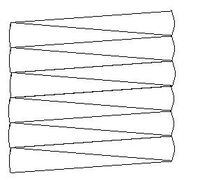Prerequisites[]
- The Pythagorean Theorem
- The trigonometric functions sine and cosine
- Integration
Proof[]

A circle in standard position
Construct a circle of radius in standard position—that is, with center at . Plot the radius of the circle such that it lies in the first quadrant of the Cartesian plane. Let represent the angle subtended by r and the x-axis (see figure at right). By the Pythagorean theorem:
Which yields the upper half of the circle on the domain interval . Let represent the area of the circle. Then,
Our integral resists solution as is, impeded by the radical. Note that . Equivalently:
Substituting the trigonometric identity into the integral, we obtain:
Which cannot be evaluated without changing the variable of integration. Beginning with:
Substituting back into the integral and taking care to change the interval of integration, we arrive at:
QED
Proof - Geometric Interpretation[]
If a circle were cut into equal slices and alternatively staggered such that it resembled a rectangle having two flat opposite ends and the other two opposite ends were rounded with the curvature of circles edge. As illustrated in the image.
The flat bases have a length equal to the radius of the circle. The two rounded sides have a total length equal to that of the circles circumference.
The area of this rectangle may be approximated by multiplying the length and width, in this case the radius by what would be less than one-half the circumference.
As the number of slices increases toward infinite, the rounded sides more and more approximate one-half the circumference. Thus the length of this shape approaches one-half the circumference, and the error becomes closer to zero. The shape as a whole approaches that of a true rectangle, and the area approaches .
Proof - Romil Sirohi's Proof[]
We will assume you know that any function rotated around the y-axis has a volume of .
This can be proved using Shell integration, a method which never uses the area of a circle, only the circumfrence. Set , and integrate from to 0. ( is just an indpendent variable with no relation to what so ever.) We get a cylinder with a height , and radius .
is our formula for our volume. Evaluate the integral, and we get as our formula for the area of a cylinder. A cylinder with a base and height , will have a volume .
Divide by , . A will be the area of a circle becuase our base is a circle, so the area of a circle =






![{\displaystyle [-r,r]}](https://services.fandom.com/mathoid-facade/v1/media/math/render/svg/2308572207e32cf0963186472447c6c10027ff8f)












![{\displaystyle A=-2r^{2}\left[\theta -{\frac {\sin(2\theta )}{2}}\right]_{\frac {\pi }{2}}^{0}}](https://services.fandom.com/mathoid-facade/v1/media/math/render/svg/14c79aa73be800de43a5dc301c00b9054134dc64)












